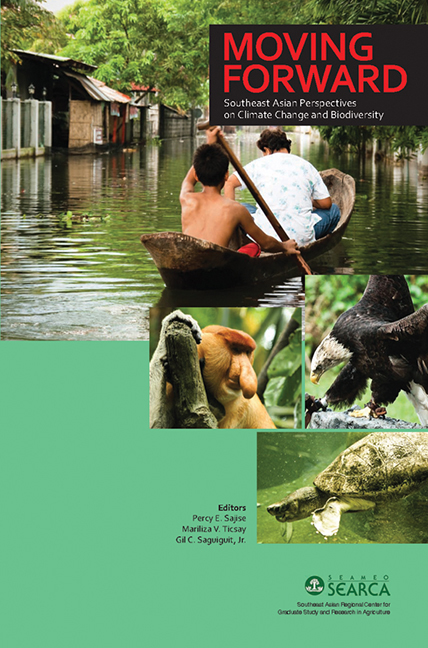Book contents
- Frontmatter
- Contents
- Tables
- Figures
- Foreword
- Preface
- Contributors
- Acronyms
- INTRODUCTION
- REGIONAL PERSPECTIVES AND CROSS-CUTTING ISSUES
- COUNTRY PERSPECTIVES
- 5 Animal Genetic Resource Conservation and Climate Change in Cambodia: Reducing Livestock to Decrease GHG Emission?
- 6 Malaysia's Current Policy and Research Initiatives Toward Climate Change: Impacts to Biodiversity
- 7 Anticipated Impacts of Climate Change on Marine Biodiversity: Using Field Situations that Simulate Climate Change in Singapore
- 8 Climate Change and Biodiversity in the Philippines: Potential Impacts and Adaptation Strategies
- 9 Research Initiatives on Climate Change Impacts and Adaptation in Thailand
- 10 The Role of Biodiversity in Climate Change Mitigation in Vietnam: The Red River Estuary - Ba Lat Case Study
- 11 Implications of the Dutch-Philippines Biodiversity Research on the Impacts, Vulnerability, and Adaptation to Climate Change: The Coastal Ecosystem
- CHALLENGES AND FUTURE ACTIONS
- Index
11 - Implications of the Dutch-Philippines Biodiversity Research on the Impacts, Vulnerability, and Adaptation to Climate Change: The Coastal Ecosystem
from COUNTRY PERSPECTIVES
Published online by Cambridge University Press: 21 October 2015
- Frontmatter
- Contents
- Tables
- Figures
- Foreword
- Preface
- Contributors
- Acronyms
- INTRODUCTION
- REGIONAL PERSPECTIVES AND CROSS-CUTTING ISSUES
- COUNTRY PERSPECTIVES
- 5 Animal Genetic Resource Conservation and Climate Change in Cambodia: Reducing Livestock to Decrease GHG Emission?
- 6 Malaysia's Current Policy and Research Initiatives Toward Climate Change: Impacts to Biodiversity
- 7 Anticipated Impacts of Climate Change on Marine Biodiversity: Using Field Situations that Simulate Climate Change in Singapore
- 8 Climate Change and Biodiversity in the Philippines: Potential Impacts and Adaptation Strategies
- 9 Research Initiatives on Climate Change Impacts and Adaptation in Thailand
- 10 The Role of Biodiversity in Climate Change Mitigation in Vietnam: The Red River Estuary - Ba Lat Case Study
- 11 Implications of the Dutch-Philippines Biodiversity Research on the Impacts, Vulnerability, and Adaptation to Climate Change: The Coastal Ecosystem
- CHALLENGES AND FUTURE ACTIONS
- Index
Summary
The Biodiversity Research Programme (BRP) for Development in Mindanao, with focus on Mt. Malindang and its environs, is a long-term North-South research endeavor on biodiversity and sustainable development. The Programme started in 1997 through the joint efforts of The Netherlands and the Philippines. Its implementation was coordinated by SEARCA with funding provided by the Netherlands Ministry of Development Cooperation (DGIS).
BRP was initiated by The Netherlands Development Assistance Research Council (RAWOO) in 1996. A technical mission was formed and one of the recommendations was to establish a collaborative Philippine-Netherlands biodiversity research programme for development in the Philippines. The programme then launched its first mission in 1997 through a national workshop organised by SEARCA. The workshop brought together researchers, policy makers, and stakeholders in order to design the research agenda of the programme based on the needs and questions relevant to biodiversity conservation in the Philippines.
Premised to be a biodiversity hotspot, Mt. Malindang was selected as the project site because of its rich biodiversity. This biodiversity is now under threat of being destroyed. Mt. Malindang has been declared a national park in 1971 (RA 6266), and integrated under the National Integrated Protected Areas System (NIPAS) in 1992 (RA 7586). In July 2004, Mt. Malindang was declared a protected area with the passage of RA 9304, otherwise known as the Mt. Malindang Act.
The location of Mt. Malindang in Mindanao was also considered in the site selection. This island group is one of the areas least served by international research funding because of its location in the southernmost part of the Philippines and its armed conflicts. The research site was also viewed as a possible springboard from which similar biodiversity conservation initiatives throughout the country could be launched.
THRUSTS
BRP envisioned for an “economically and culturally prosperous community, living harmoniously in a sustainable environment, where biodiversity conservation is founded on an integrative and participatory research model.”
- Type
- Chapter
- Information
- Moving ForwardSoutheast Asian Perspectives on Climate Change and Biodiversity, pp. 209 - 228Publisher: ISEAS–Yusof Ishak InstitutePrint publication year: 2010



